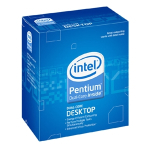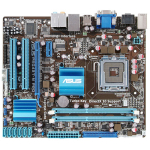System Buyers' Guide: PCs for Under $1000
by Sean Hollister on February 12, 2010 2:00 AM EST- Posted in
- Guides
Intel Entry-Level PC
From Pentium 4 to Pentium D, Core 2 Duo to Core 2 Extreme—not to mention the occasional Celeron and Xeon—Intel's LGA 775 socket has had a long, illustrious six years housing powerful processors. We're not going to write LGA 775's obituary quite yet, as Intel hasn't officially announced an end-of-life date for the aging socket. But with widespread availability of a mainstream successor in LGA 1156 and leaked Intel roadmaps depicting only the Pentium Dual-Core chips to continue through 2010, the writing's on the wall. If you buy an LGA 775 system today, don't expect to be able to easily upgrade its processor through retail channels next year.
However, none of that says an LGA 775 processor and motherboard can't be the base for a fantastic budget PC. LGA 775 chips have proven to be excellent overclockers, with many of the recent 45nm SKUs capable of reaching speeds up to 4GHz at stock voltage. They are mature and reliable; multiple AnandTech editors still use them in their home PCs, and clock for clock they continue to compete well against AMD's offerings (albeit at generally higher prices and/or lower core counts). And should you still want to upgrade at some point down the road, the aforementioned wide variety of compatible processors means that you may still find an opportunity to do so in the secondhand market.
| Intel Entry-Level System | ||
| Hardware | Component | Price |
| Processor | Intel Pentium Dual-Core E5300 (2.6GHz x2, 45nm, 2MB L2 Cache) |
$65 |
| Cooling | CPU Retail HSF | $0 |
| Video | Onboard | $0 |
| Motherboard | ASUS P5G43T-M Pro LGA 775 Micro ATX | $80 |
| Memory | G.Skill Ripjaws 4GB DDR3-1600 F3-12800CL9D-4GBRL | $105 |
| Hard Drive | WD Caviar Blue 500GB WD5000AAKS | $54 |
| Optical Drive | Sony Optiarc Model AD-7240S-OB 24X DVDRW SATA | $28 |
| Audio | Onboard | $0 |
| Case | Cooler Master Centurion 5 CAC-T05-UW Mid Tower ATX | $55 |
| Power Supply | OCZ ModXStream Pro 500W ATX12V SLI Certified, CrossFire Ready, 80 PLUS Certified Modular Active PFC (before $25 Rebate) | $65 |
| Base System Total | $452 | |
| Display | ASUS VW193TR Black 19" 5ms Widescreen LCD (1440 x 900) | $120 |
| Speakers | Built-in Monitor | $0 |
| Input | Microsoft B2L-00045 Comfort Curve Black USB Keyboard and Optical USB Mouse - OEM | $22 |
| Operating System | Microsoft Windows 7 Home Premium OEM 1-Pack (for System Builders) | $105 |
| Complete System Total | $699 | |
| Plus Estimated Shipping (within Continental U.S.) | $715 | |
| Rebates | -$25 | |
| Final Total (less tax, if applicable) | $690 | |
 |
Since December 2008, our CPU of choice for the Intel Entry-level PC has been the excellent Pentium Dual-Core E5200 Wolfdale: a 2.5GHz, $64 processor that hit a sweet spot in the price/performance ratio that no other Intel chip could match. Today, we're going to stray ever so slightly from our previous recommendation and suggest you pick up its bigger brother, the 2.6GHz Pentium Dual-Core E5300 instead. Why? Simply put, the $65 E5300 is the exact same chip, but with a 13x multiplier that immediately makes it 100MHz faster—for only $1 more. And considering that 13x multiplier also means a higher maximum overclock than that of the 12.5x E5200, we believe that extra $1 is money very well spent.
It's also important to note that since late 2009, new E5300 processors have been shipping with Intel's Virtualization Technology, or VT-x. If you're hoping to run the Windows XP Mode under Windows 7 Professional/Ultimate, you'll need this feature and you won't find it on the E5200. You can indeed find VT-x on the cheaper $60 Celeron E3400, but only in exchange for a significant drop in performance. On the other hand, if you're looking to spend even more on a processor and don't plan to overclock, you might consider the 2.8GHz E6300 for $80, which has guaranteed VT-x support and a 1066MHz (vs. 800MHz) FSB speed.
 |
With LGA 775 fading from the public eye, it was imperative that we find as capable and upgradable a motherboard as we could fit into our budget while such boards were still to be found. To that end, we chose the ASUS P5G43T-M Pro. At only $80, the P5G43T-M Pro features both the Intel G43 GMCH as well as the ICH10 Southbridge, allowing for acceptable video playback with the X4500 IGP and plenty of storage options, including a single IDE header and six SATA 3Gb/s ports. The board supports all LGA 775 processors up to the Core 2 Extreme series, 8GB of DDR3-1333 memory, and has excellent connectivity with VGA, DVI and HDMI ports, six USB 2.0 ports, Gigabit LAN and Realtek ALC887 8-channel HD audio, in addition to combo PS/2 and optical S/PDIF audio out. Onboard, there's a single PCIe x16 slot, a PCIe x1 slot and two PCI slots, as well as headers for six more USB 2.0 ports. There's no hardware RAID support, only a single chassis fan connector and you won't be playing new games or natively decoding H.264/VC-1/MPEG2 streams with the integrated X4500 graphics, but the P5G43T-M Pro's got a pretty solid layout with room to grow.
All other components are the same ones chosen for our AMD Entry-level PC, up to and including that 4GB of G.Skill DDR3-1600 memory. Even for an LGA 775 rig—where the majority of affordable motherboards use DDR2—we felt it didn't make financial sense to go with the slower modules when quality DDR3 is available for a marginal price increase, and can be repurposed if/when you build your next PC. However, if you're looking to squeeze out every last drop of value, you can pick up low-end DDR2-800 memory instead as with our AMD build. In that case, our motherboard recommendation is the ASRock G43Twins-FullHD (a similarly featured G43/ICH10 Micro ATX with separate DDR2 and DDR3 slots and a DVI/DisplayPort riser card) for $75. Just be aware that the G43Twins-FullHD uses jumper settings for its memory divider, so you'll need to check the manual in order to properly set the board for your memory.










86 Comments
View All Comments
jonp - Thursday, February 18, 2010 - link
start with the intel mainstream; drop the hd 4850, case and power supply; use Antec Two Hundred case $39.99, Antec Earthwatts Green EA-380D power supply $39.99; the base system is $482!!! For only $30 more than the E5300 configuration! The case has two BIG fans, power supply on the bottom; usb, indicator lights, power and reset buttons on the top-front (since most sit on the floor) and very quiet. Even at 380 watts, the power supply is probably 4 times more than this system configuration will use and the supply is used in a more efficient way (i3-530, asus p7h55-m pro, 4gb ddr3, wd blue drive, sony optiarc, media reader, 3rd case fan == 82 wall-watts under IntelBurn Test (4 threads)).dankegel - Wednesday, March 3, 2010 - link
I did some research yesterday on my own, and also chose the Antec Two Hundred case. I may switch to the Earthwatts supply, thanks.My proposed configuration is written up at
http://kegel.com/new-computer-2010.html">http://kegel.com/new-computer-2010.html
please check it out and let me know what you think.
I'm aiming at really fast C compilation and entry level
(but not crappy) gaming.
JonnyDough - Tuesday, February 16, 2010 - link
"But now, by popular demand, we've separated mail-in rebates and added estimated shipping costs within the continental United States as well. With this measure in place, discerning buyers can find the true out-of-pocket cost of any of our suggested builds without having to consult a virtual shopping cart (except for taxes—you're on your own there)."THANK YOU for that! :)
kjartan333 - Monday, February 15, 2010 - link
$120 for a case and power supply has no place in a budget build!No blu-ray is listed because $60 is too much... No graphics card either...
But for some reason a fancy case with 5 external bays and a 500w power supply is necessary? Get real.
zerobug - Sunday, February 14, 2010 - link
If you are not a gamer and use your PC to surf the net, watch movies, store pictures, and do office work, you do not need to upgrade. Ditch windows, move to Linux, and you'll gain a modern operation system and applications that can achieve all those tasks fast and efficiently even with a 10 years old machine.v12v12 - Tuesday, February 23, 2010 - link
And a STEEP arse LEARNING CURVE required for even the most mundane problems. The person you're talking about is NOT going to need to use, nor want to use Nix. This person is a drone, another worker-bee in society using their computer to surf sites for mindless shopping, gossip sites and the like... Great idea, logical, but not practical for the worker-bee drone.I wish they were smarter... but, yadda...yadda...
hombre - Wednesday, March 24, 2010 - link
My wife uses Ubuntu Linux every day, and she's certainly not a techie. It came pre-installed on her netbook, and the only thing I had to help her with was setting up the wireless adapter, and that's only because she didn't know what our WEP key was.gychang - Saturday, February 13, 2010 - link
I am very interested in the AMD budget for general and photoshop use at home, due to space constrsints is there a thinner or smaller case that will fit with all suggested components?thanks,
gychang
qwertymac93 - Sunday, February 14, 2010 - link
like this one?http://www.newegg.com/Product/Product.aspx?Item=N8...">http://www.newegg.com/Product/Product.aspx?Item=N8...
or this one?
http://www.newegg.com/Product/Product.aspx?Item=N8...">http://www.newegg.com/Product/Product.aspx?Item=N8...
or this one?
http://www.newegg.com/Product/Product.aspx?Item=N8...">http://www.newegg.com/Product/Product.aspx?Item=N8...
Blur - Saturday, February 13, 2010 - link
I'm really glad to see this feature come back, i built my first system using the parts recommended in a previous guide.